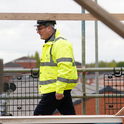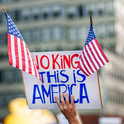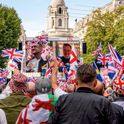The long story of democracy and the rule of law in the United Kingdom has not always been a peaceful one, with disagreements profoundly dividing the country—with recent times no exception. Westminster Hall was the site of four courts which saw the development of the English law for almost 700 years and, as the great hall of the populace, it saw the first gathering of the Commons, in 1265.
Nowadays, the United Kingdom has by far the largest legislature of any democracy in the world and one of the busiest. It has employed seemingly every room in the vast Palace of Westminster, sometimes with several occupants to each space, but parliament has worked for over 160 years with one room remaining empty—unused except as a silent receptacle for its fascinating secrets.
This significant and exciting find was made recently as the result of archival research by Elizabeth Hallam Smith and Mark Collins of the Architecture and Heritage Team at the Houses of Parliament—a 17th-century doorway which led from Westminster Hall to the House of Commons chamber when it was situated in the former royal chapel of St Stephen. Broken through the massive Norman east wall of Westminster Hall, two meters thick, this doorway led members first into the beautiful fan-vaulted cloister, dating from the time of Henry VIII, and then up a staircase to the chamber. The chapel had been given at the Dissolution to the House of Commons as its first permanent chamber; it was replaced in the 19th century by St Stephen’s Hall.
The ceiling timbers were analysed through the dendro-isotope technique and dated to 1659 and this date ties in with surviving accounts which state that a doorway was made in 1660-61 for the coronation banquet of Charles II. The route was used by part of the procession which passed from the old House of Lords into the hall towards the front of the dais on which the king and queen were seated for the banquet. Thereafter, the doorway was used at subsequent coronations, and day-to-day by MPs until a new entrance was made through the south wall of the hall and up new stairs to the Commons chamber.
Great figures of the Restoration and Georgian periods would have frequently passed through this way, for instance Samuel Pepys, Robert Walpole—Britain’s first de facto prime minister, Charles James Fox, William Pitt and Edmund Burke. The discovery has much to tell us about the history of parliament and can perhaps also tell us something about the history of democracy. What else do we know?
Although blocked up around 1800, the doorway was briefly revealed twice before the recent rediscovery. It was found by the architect Charles Barry during the Victorian rebuilding of the Palace of Westminster but was then closed in and largely forgotten. Following bomb damage to the cloister during the Second World War, the doorway was again briefly revealed, this time by the architect Giles Gilbert Scott. On this occasion, a small secret access door was set into the panelling of the west cloister. But this was—again—completely forgotten until now because of the subtle nature of its construction; it took on the appearance of a cupboard holding electrical services. The desks of MPs and staff were situated next to the cupboard from the 1960s until recently but the key had vanished and there was only a hint of a door in the shape of a tiny brass keyhole.
On the Westminster Hall side, the doorway is located on the large steps below the entrance to the Chapel of St Mary Undercroft; the position was later marked by a brass plaque. Inside, the passage is about two meters by one and a half meters, with a stone floor and plastered brick walls. Four large iron “pintles” or hinge-pins are fitted into the wall to the left and right which would have held two wooden doors, now missing. Part of the stone framing for the doors is still visible.
The area is a fascinating time capsule because the men who found the space in 1851 left their comments in a vivid piece of graffiti:
“This room was enclosed by Tom Porter who was very fond of Ould Ale.
- Congdon Mason T. Parker
- Williams P. Duval
- Terrey
Aug 11th 1851
Real Demorcrats”
Identifying themselves as “Real Demorcrats” indicated that the masons in their little makeshift mess room were probably part of the Chartist movement which campaigned for working-class men to be given the vote. Masons at this period were also supported by the most militant of the trade unions—the construction of the new Houses of Parliament had been held up by a mason’s strike ten years before the message was written on the wall. The Chartists’ demands were rejected, and Porter’s graffiti was left forgotten for decades. Full parliamentary democracy in the UK was not achieved until 1928.
The radical men who bricked up their passageway into the two courts of justice and freedom—one way leading to the open hall of the people and the other way into the Commons chamber—cannot have failed to feel the irony and disappointment of closing the doors on those first, long, painful steps towards universal suffrage.
When the doorway was again revealed after the Second World War, the mason who found and repaired it also left his name and the date: Alan Leiper, 1950.
An additional discovery in the room was the large Osram lightbulb marked “HM Government Property,” which lit up immediately once the old switch was thrown when the room was first opened by the palace locksmiths.
Further research will be carried out on this important piece of standing archaeology. Once historians have concluded their investigation the door will have to be locked again because of the fragility of its built fabric and delicate pencil message, but its whereabouts have now been carefully recorded.












